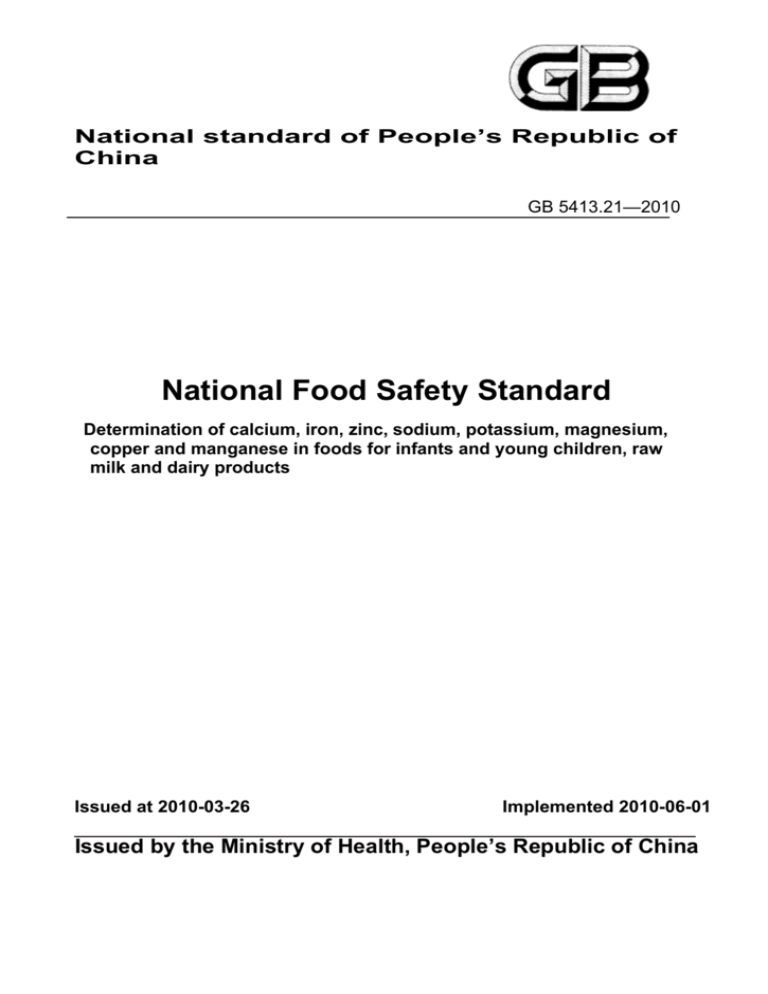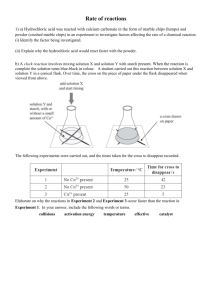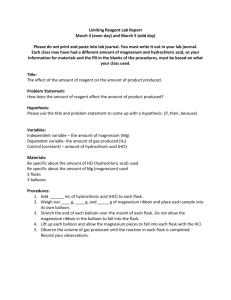Determination of calcium, iron, zinc, sodium, potassium, magnesium
advertisement

National standard of People’s Republic of China GB 5413.21—2010 National Food Safety Standard Determination of calcium, iron, zinc, sodium, potassium, magnesium, copper and manganese in foods for infants and young children, raw milk and dairy products Issued at 2010-03-26 Implemented 2010-06-01 Issued by the Ministry of Health, People’s Republic of China Preface This standard replace GB/T5413.21-1997, “Measurement of calcium, ferrum, zinc, sodium, potassium, magnesium, copper and manganese in formulated foods and milk powder for infants and young children” The main changes in this standard compared with GB 5413.21-1997 are as following: --Certified reference stock can be directly purchased in method 1 --The preparation standard stock solution and standard working solution in method 1 --The dilution steps for sample preparation in method 1. --Add the second measurement method of inductively coupled plasma atomic emission spectrometry. Versions of standard substituted by this standard are: --GB 5413-1985、GB/T 5413.21-1997. GB ××××—×××× Determination of calcium, ferrum, zinc, sodium, potassium, magnesium, copper and manganese in food for infants and young children and dairy products 1 Scope This standard regulate the method for the determination of calcium, ferrum, zinc, sodium, potassium, magnesium, copper and manganese in food for infants and young children and dairy products. This standard applies to the determination of calcium, ferrum, zinc, sodium, potassium, magnesium, copper and manganese in food for infants and young children and dairy products. 2 Normative cited documents The reference cited in this standard is necessary. For the cited documents which are labeled with date, all their subsequent modification sheets or modified versions are not applicable for this standard. For the cited documents which are not labeled with date, their latest versions are applicable for this standard. Method 1 Atomic absorption spectrometry 3 Principle Dry ash the samples to break down organic part. Dissolve the inorganic ions in the ash by acid. Aspirate into air-acetylene flame for atomization. Measure absorbance under specific wavelength. When measuring calcium and magnesium, lanthanum should be added as releasing agent to eliminate the interference by phosphoric acid. 4 Reagents and materials Unless additionally specified, the reagents used by this method are GR, and water is the second grade water specified by GB/T6682. 4.1 Hydrochloric acid 4.2 Nitric Acid 4.3 Lanthanum solution 4.4 Potassium chloride, molecular weight: 74.55, chromatography grade 4.5 Sodium chloride, molecular weight: 58.44, chromatography grade 4.6 Calcium carbohydrate: molecular weight: 100.05, chromatography grade 4.7 Purified magnesium, chromatography grade 4.8 Purified zinc, chromatography grade 4.9 Iron powder, chromatography grade 4.10 copper, chromatography grade 4.11 Manganese, chromatography grade 4.12 Hydrochloric acid A(2%): Dilute hydrochloric acid 2ml (4.1) to 100 ml with water. 4.13 Hydrochloric acid B(20%): Dilute hydrochloric acid 20mL (4.1) to 100mL with water. 4.14 Nitric acid (50%): Dilute 20mL nitric acid (4.2) to 100mL with water. 4.15 Lanthanum solution (50g/L): weigh 29.32g lanthanum oxide (4.3) and wet with 25mL deionized water. Slowly add 125mL hydrochloric acid (4.1) and dissolve the lanthanum oxide. Dilute with deionized water to 500mL. 4.16 Potassium standard stock solution (1000 ug/ml): Weigh 1.9067g of dried potassium chloride (4.4) , Dissolve in hydrochloric acid A (4.12) and dilute to 1000 ml in volumetric flask. Can purchase the standard stock solution directly. 4.17 Sodium standard stock solution (1000 ug/ml): Weigh 2.5420g dried sodium chloride (4.5) Dissolve in hydrochloric acid A (4.12) and diluted to 1000mL in volumetric flask. Can purchase the standard stock solution directly. 4.18 Calcium standard stock solution (1000 ug/ml): Weigh 2.4963g dried sodium chloride (4.6) Dissolve in 100 ml hydrochloric acid B (4.13) and diluted to 1000mL in volumetric flask. Can purchase the standard stock solution directly. 4.19 Magnesium standard stock solution (1000 ug/ml): Weigh 1.0000g purified magnesium (4.7) Dissolve in 40 ml nitric acid (4.14) and diluted to 1000mL in volumetric flask. Can purchase the standard stock solution directly. 4.20 Zinc standard stock solution (1000 ug/ml): Weigh 1.0000g purified zinc (4.8) .Dissolve in 40 ml nitric acid (4.12) and diluted to 1000mL in volumetric flask. Can purchase the standard stock solution directly. 4.21 Iron standard stock solution (1000 ug/ml): Weigh 1.0000g iron powder (4.9) .Dissolve in 40 ml nitric acid (4.12) and diluted to 1000mL in volumetric flask. Can purchase the standard stock solution directly. 4.22 Copper standard stock solution (1000 ug/ml): Weigh 1.0000g copper (4.10) .Dissolve in 40 ml nitric acid (4.12) and diluted to 1000mL in volumetric flask. Can purchase the standard stock solution directly. 4.23 Manganese standard stock solution (1000 ug/ml): Weigh 1.0000g manganese (4.11) .Dissolve in 40 ml nitric acid (4.12) and diluted to 1000mL in volumetric flask. Can purchase the standard stock solution directly. 4.14 Standard stock solutions of different elements Standard stock solutions of calcium, iron, zinc, sodium, potassium and magnesium: pipette 10.0mL standard solution of calcium(4.18), iron (4.21), zinc (4.20) and potassium (4.16) , 5.0mL standard solution of sodium (4.17) and 1.0mL magnesium standard solution (4.19) into 100mL quartz volumetric flask and make up to the mark with hydrochloride acid solution A (4.12) to obtain the standard stock solution of the above different elements. Concentration for calcium, iron, zinc, potassium is 100.0µg/mL; sodium: 50.0µg/mL; magnesium:10.0µg/mL Standard stock solutions of manganese and copper: accurately Pipette 10.0mL manganese standard solution (4.23) into 100 ml volumetric flask and make up to the mark with hydrochloric acid A(4.12), from which 4.0mL is diluted with hydrochloric acid A (4.12) to 100mL to obtain manganese stock solution. Accurately pipette 10.0mL copper standard stock solution (4.22) into 100 ml volumetric flask and make up to the mark with hydrochloric acid A(4.12), from which 6.0mL is diluted with hydrochloric acid A (4.12) to 100mL to obtain copper stock solution.concentration is: manganece: 4.0µg/mL; copper: 6.0µg/mL. 5 Equipments and devices: 5.1 Atomic absorption spectrometer 5.2 Hollow cathode lamps of calcium, iron, zinc, sodium, potassium, magnesium, copper and manganese 5.3 Acetylene gas and air compressing engine 5.4 Quartz crucible or porcelain crucible 5.5 Muffule furnace 5.6 Balance: nearest to 0.1mg. 6 Analysis steps 6.1 Sample preparation Approximately weigh 5g of well-mixed solid sample or 15g (nearest to 0.0001g) in crucible (5.4) and carbonize on electric furnace with low powder until no black smoke. Heat in Muffule furnace (5.5) under 490 ℃ until the sample becomes white ash. If there are any black carbon granules, add drops of nitric acid (4.14) after cooling down. Evaporate on the electric furnace using low power and put into 490℃ muffule furnace again to be incinerated to white ash. After sample is cooled to room temperature, add 5mL hydrochloric acid B(4.13) , heat on the electric furnace to make the ash thoroughly dissolved. The sample is cooled down to room temperature and moved to 50mL volumetric flask and make up to the mark with water. At the same time, at least two blank control is prepared at the same time. 6.2 Testing solution preparation of samples 6.2.1 Ca, Mg testing solution Pipette 1.0 ml accurately from 50 solution (6.1) into 100 ml volumetric flask. Add 2 ml Lanthanum solution (4.15). Make up to the mark with water. Same operation to blank solution 6.2.2 Na testing solution Pipette 1.0 ml accurately from 50 solution (6.1) into 100 ml volumetric flask. Make up to the mark with hydrochloride acid solution A (4.12). Same operation to blank solution 6.2.3 K testing solution Pipette 1.0 ml accurately from 50 solution (6.1) into 100 ml volumetric flask. Make up to the mark with hydrochloride acid solution A (4.12). Same operation to blank solution 6.2.4 Testing solution for Fe, Zn, Mn and Cu 50 ml solution (6.1) directly aspirate to the AAS. At the same time blank control solution is measured. 6.2.5 In order to make sure concentration of testing solution fall into the range of standard curve, dilution volume can be adjusted. 6.3 Determination 6.3.1 Preparation of standard curve 6.3.1.1 Preparation of standard series dilutions According to the volume listed in table 1, pipette standard stock solutions of iron, zinc, sodium, potassium, manganece and copper into 100mL volumetric flask. Make up to the mark with hydrochloric acid (4.12) . Pipette accurately standard stock solution of Ca and Mg into volumetric flasks and make up to the mark with water. The standard working solutions of different concentrations for different elements are prepared, concentrations are listed in table 2. Table 1 Volume of standard intermediate solutions for different elements required for the preparation of standard series dilutions Number 1 2 3 4 5 K mL 1.0 2.0 3.0 4.0 5.0 Ca mL 2.0 4.0 6.0 8.0 10.0 Na mL 2.0 4.0 6.0 8.0 10.0 Mg mL 2.0 4.0 6.0 8.0 10.0 Zn mL 2.0 4.0 6.0 8.0 10.0 Fe mL 2.0 4.0 6.0 8.0 10.0 Cu mL 2.0 4.0 6.0 8.0 10.0 Mn mL 2.0 4.0 6.0 8.0 10.0 Table 2 Concentrations of standard series dilutions for different elements µg/mL Number K Ca Na Mg Zn Fe Cu Mn ug/ml ug/ml ug/ml ug/ml ug/ml ug/ml ug/ml ug/ml 1 1.0 2.0 1.0 0.2 2.0 2.0 0.12 0.08 2 2.0 4.0 2.0 0.4 4.0 4.0 0.24 0.16 3 3.0 6.0 3.0 0.6 6.0 6.0 0.36 0.24 4 4.0 8.0 4.0 0.8 8.0 8.0 0.48 0.32 5 5.0 10.0 5.0 1.0 10.0 10.0 0.60 0.40 6.3.1.2 Plotstandard curve Optimize working condition of equipment according to the equipment manual Select the sensitive absorption lines K 766.5nm、Ca422.7nm、Na589.0nm、Mg285.2nm、Fe248.3nm、 Cu324.7nm、Mn279.5nm、Zn213.9nm. After the equipment is adjusted, set zero point with hydrochloric acid (4.2) aspirated with capillary tube for measurement of iron, zinc, sodium, potassium, copper and manganese. When measuring calcium and magnesium, first pipette 2.0mL lanthanum solution (4.15) and diluted to 100mL with water. This solution is used to set zero point through capillary tube. Measure absorbance of standard working solution. Plot the Standard curve using concentrations of standard series solution as X-axis and corresponding absorbance as Y-axis. 6.3.2 Determination of sample solutions Optimize working condition of equipment, hydrochloric acid (4.2) is used for zeroing in the measurement of iron, zinc, sodium, potassium, copper and manganese. In the measurement of calcium and magnesium, 2.0mL lanthanum solution (4.15) is diluted to 100mL with water to make the solution for zeroing. Absorbance of sample solution and blank solution is measured according to the following steps. Corresponding mass concentration is obtained from standard curve. 7 Result expression The content of calcium, magnesium, sodium, potassium, iron and zinc (X) is expressed as mg/100g, and calculated using equation (1): In the equation: X—content of elements in the samples, mg/100g; C1—concentration of elements in the samples, µg/mL; C2—concentration of elements in the blank solution, µg/mL; V—volume of the sample solution, mL; A—dilution times of the sample solutions; m—mass of the samples, g. The content of calcium, magnesium, sodium, potassium, iron and zinc (X) in the samples is expressed as mg/100g, and calculated using equation (2): In the equation: X—content of elements in the samples,µg/100g; C1—concentration of elements in the samples, µg/mL; C2—concentration of elements in the blank solution,µg/mL; V—volume of the sample solution, mL; A—dilution times of the sample solutions; m—mass of the samples, g. The result is expressed as the arithmetic mean value of two independent measurements. The calculation results of calcium, magnesium, sodium, potassium, manganese and copper need to be accurate to one digit after the decimal point. For iron and zinc, the result is required to be accurate to two digits after the decimal point. 8 Precision The absolute difference between two independent measurements performed under repeatability conditions should not exceed 15% of the arithmetic mean value. The second measurement method of inductively coupled plasma atomic emission spectrometry 9 Principle Sample is incinerated and digested using dry method, and measured with inductively coupled plasma atomic emission spectrometry after diluted to appropriate volume. External reference method is used for quantification. 10 Reagents and materials Unless additionally specified, the reagents used by this method are GR, and water is the first grade water specified by GB/T6682. 10.1 Hydrochloride acid 10.2 Nitric acid solution 10.3 Nitric acid solution (50%): dilute 50 ml (10.2) nitric acid to 100 ml with water. 10.4 Hydrochloric acid solution A (4%): dilute 4 ml (10.1) nitric acid to 100 ml with water. 10.5 Hydrochloric acid solution B(40%): dilute 40 ml (10.1) nitric acid to 100 ml with water. 10.6 Standard stock solution of 8 elements: Standard stock solution of single element can be prepared using method specified in GB/T602 or using certified reference material.Concentration is 1.0 mg/mL (or 0.5 mg/mL). 11 Equipments and devices: 11.1 Inductively coupled plasma atomic emission spectrometry 11.2 Analytic balance: accuracy is 1mg. 11.3 Muffle furnace 11.4 Electric furnace:1~2 kw. 11.5 Porcelain crucible 12 Analysis Procedure 12.1 Sample preparation If Samples are powder and should be mixed well before analysis. If samples are granules with bigger size, then some samples should be crashed or grinded before measurement. 12.2 Sample preparation Weigh 5g samples (nearest to 1mg) into porcelain crucible and carbonize on electric furnace using low power until no smoke can be seen. Ash in muffule furnace at 550℃ for 2 hours. If there are any black carbon granules, drops of nitric acid (10.1) is added after cooling down. Evaporate on the electric furnace using low power and ash in muffle furnace at 490℃ for 0.5 hour. Cool down and add 5 ml of Hydrochloric acid solution B (10.5) Heat on the electric furnace to completely dissolve the ashes. After cooling down, the sample is moved to 25mL volumetric flask and make up to the mark with water. If there are any precipitates, the solution should be filtered. 12.3 Parallel experiment The same sample is measured in parallel according to the above steps. 12.4 Blank experiment Only no sample is added, all other steps are carried out according to the sample processing and measurement steps. 12.5 Reference operation condition of equipments Power: 1.20 kW, Plasma gas flow rate: 15L/min, Pressure of the atomizer: 200kPa, Assistant gas flow rate: 1.50L/min, Stable time lag: 15s, Sample injection time lag: 20s, Frequency of reading: 3 times, Recommended analytical spectral lines of elements are listed in table 1: Table 1 Recommended analytical spectral lines of elements Unit is nanometer Element Wavelength of analytical spectral lines Ca 315.887, 317.933 Mg 279.553,280.270 Fe 234.350,238.204,259.940 Mn 257.610 Cu 324.754,327.395 Zn 202.548,206.200 K 766.491 Na 588.995,589.592 12.6 Preparation of mixed standard solution Mixed standard solutions, whose concentrations are listed in the following table, is prepared from stock solution after series dilution with hydrochloric acid solution A (10.4). Table 4 Element concentrations of mixed standard solution Serial Ca Mg Fe Mn number ug/ml ug/ml ug/ml ug/ml 1 0 0 0 0 2 10.0 0.5 5.0 0.1 3 15.0 1.0 10.0 0.2 4 20.0 1.5 15.0 0.3 5 25.0 2.0 20.0 0.4 Cu ug/ml 0 0.2 0.4 0.6 0.8 Zn ug/ml 0 5.0 10.0 15.0 20.0 K ug/ml 0 10.0 20.0 30.0 40.0 Na ug/ml 0 1.0 3.0 5.0 7.0 12.7 Determination Optimize the Equipment with reference to condition listed in 12.5. Measure standard solution, blank solution and samples in turn. If concentration of certain element exceeded the standard curve, sample solution can be measured after diluted with hydrochloric acid solutionA (10.4). 13 Result expression Element content is calculated according to equation (3): In the equation X—content of elements in the samples, mg/100g; C1—concentration of elements in the samples, µg/mL; C2—concentration of elements in the samples, µg/mL; V—volume of the sample solution, mL; A—dilution times of the sample solutions; m—mass of the samples, g. The result is expressed as the arithmetic mean value of two independent measurements. Report results to 3 effective digit 14 Precision The absolute difference between two independent measurements performed under repeatability conditions should not exceed 10% of the arithmetic mean value. 15 Others Detection limit for Method I Ca: 1.0 mg/100g, Mg: 0.3mg/100g, Fe: 0.02mg/100g, Mn: 0.001mg/100g, Cu: 0.0045mg/100g, Zn: 0.02mg/100g, K:0.2mg/100g, Na: 1.5mg/100g Detection limit for Method II Ca: 0.7 mg/100g, Mg: 0.2mg/100g, Fe: 0.003mg/100g, Mn: 0.005mg/100g, Cu: 0.002mg/100g, Zn: 0.002mg/100g, K:0.7mg/100g, Na: 1.6mg/100g








